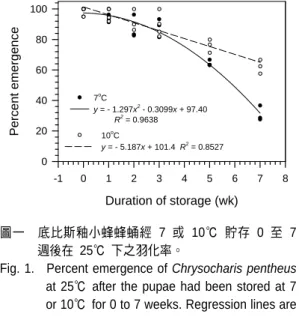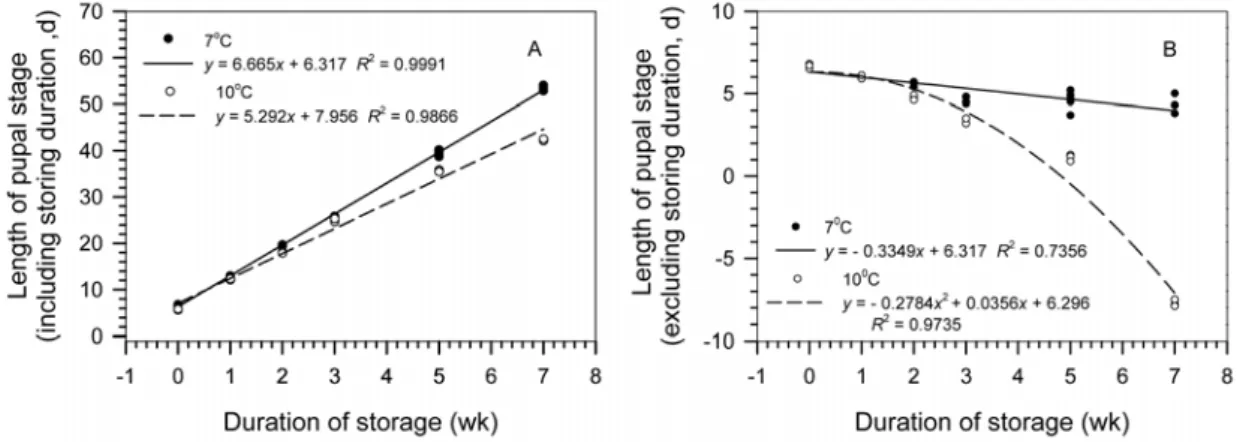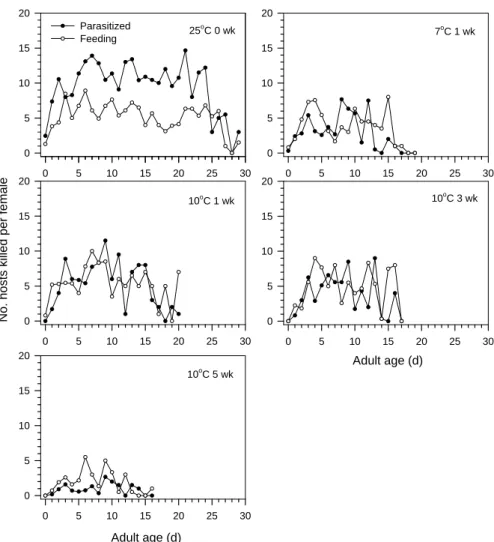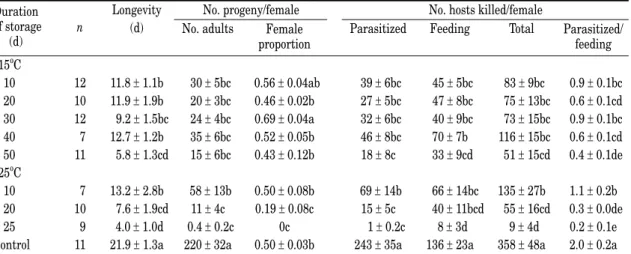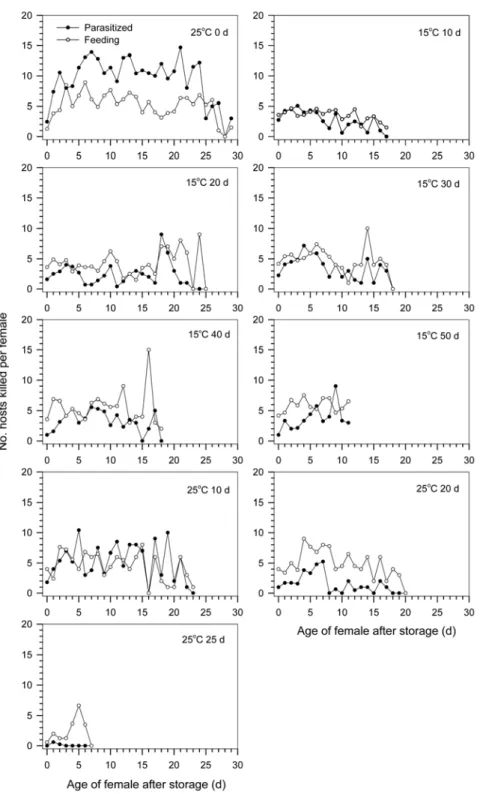研究報告
台灣昆蟲 28: 293-304 (2008) Formosan Entomol. 28: 293-304 (2008)前 言
底比斯釉小蜂 (Chrysocharis pentheus (Walker)) 為多食性,寄主範圍包括雙翅目、 鱗 翅 目 、 鞘 翅 目 及 膜 翅 目 等 178 種 以 上(Chien and Chang, 2008a)。在中國為蔬菜斑 潛蠅 (Liriomyza sativae Blanchard) 之田 間優勢寄生蜂 (Zeng et al., 1999; Liang et
al., 2001; Zhan et al., 2002; Zhao et al.,
2003; Cai et al., 2005; Ren et al., 2006),在
貯存溫度與時間對底比斯釉小蜂
(
Chrysocharis pentheus
(
Walker)) (膜翅目: 釉小蜂科) 之影響
錢景秦
1*、張淑貞
11 行政院農業委員會農業試驗所應用動物組 臺中縣霧峰鄉中正路 189 號
摘 要
底比斯釉小蜂 (Chrysocharis pentheus (Walker)) 為臺灣地區蔬菜斑潛蠅 (Liriomyza sativae Blanchard) 之優勢寄生蜂。為增進該蜂對蔬菜斑潛蠅生物防治 之利用,本文探討貯存溫度與時間對其之影響。0 日齡蛹在 7 與 10℃ 下各貯存 1 與 1~2 週後,在 25℃ 下之羽化率雖各為 95.1 與 92.1~96.0%,與對照組之 98.8% 無顯著差異;但 0 日齡蛹在 7 與 10℃ 下各貯存 1 與 1~5 週後,在 25℃ 下彼等初羽化成蜂,移入25℃ 定溫、並每日供應寄主蔬菜斑潛蠅幼蟲與純蜂蜜時, 各處理組之致死寄主能力與子蜂數,均顯著較對照組各減少 79.3~96.4 與 86.8~ 98.6%。雌蜂不論在 15 或 25℃ 下餵食純蜂蜜,各貯存 10~40 與 10 日後,移入 25℃ 定溫、且每日供應寄主與純蜂蜜後,各處理組之致死寄主能力與子蜂數,均顯 著較對照組各減少 62.3~79.6 與 73.6~90.9%。同時成蜂經貯存後,各處理組之日 產卵與取食寄主型式與對照組不一。總之,底比斯釉小蜂雖不適於貯存,但在其繁殖 或釋放過程中,若需要貯存時,本文建議其條件,為 0 日齡成蜂在 15 或 25℃ 下 餵食純蜂蜜,各貯存 10~40 與 10 日。 關鍵詞:底比斯釉小蜂、蔬菜斑潛蠅、貯存溫度、貯存時間、生育力、致死寄主能力。
日 本 為 非 洲 菊 斑 潛 蠅 (Liriomyza trifolii (Burgess)) 、 食 蜜 潛 葉 蠅 (Chromatomyia
lonicerae (Robineau-Desvoidy))、毛茛潛葉蠅
(Phytomyza ranunculi Schrank)、桃潛葉蛾 (Lyonetia clerkella (L.)) 及 柑 桔 潛 葉 蛾 (Phyllocnistis citrella Stainton) 等之田間 優 勢 或 重 要 寄 生 蜂 (Sugimoto and Ishii, 1979; Sugimoto et al., 1982; Kato, 1984; Togashi, 1988; Ikeda, 1996; Adachi, 1998; Arakaki and Kinjo, 1998; Mafi and Ohbayashi, 2004, 2006; Hondo et al., 2006)。在臺灣瓜類、豆類及番茄上,該蜂不 僅 為 蔬 菜 斑 潛 蠅 田 間 本 地 種 之 優 勢 寄 生 蜂 (Chien and Chang, unpublished data),且 由其生物性亦顯示其為有效寄生蜂 (Chien and Chang, 2008a, b)。進行害蟲生物防治 時,為配合害蟲之發生,常需貯存天敵以備適 時釋放,如此天敵之貯存蟲期與條件,即為害 蟲生物防治成敗的關鍵之一。然底比斯釉小蜂 貯存之相關資料有限,僅知該蜂壽命除受溫度 影 響 外 , 尚 受 蜂 蜜 與 其 寄 主 體 液 之 影 響 (Sugimoto and Imoarai, 1983; Chien and Chang, 2008b);另外當與寄主隔離時,該蜂 具卵吸收現象 (oosorption) (Sugimoto and Imoarai, 1983)。為深入瞭解底比斯釉小蜂之 最適貯存蟲期與條件,及貯存對雌蜂生育力與 致死寄主能力之影響,乃進行本試驗,冀能提 供該蜂貯存技術與保育措施之參考,進而增進 底比斯釉小蜂對蔬菜斑潛蠅生物防治之利用。
材料與方法
供試蟲源 在雲林縣林內鄉敏豆 (Phaseolus vulgaris L.) 上,採集被蔬菜斑潛蠅幼蟲危害之葉片, 攜回室內。攤開葉片,稍陰乾後,再分裝於有 透氣孔之封口塑膠袋。待斑潛蠅成蠅與底比斯 釉小蜂羽化,供做後續試驗飼育之蟲源。 供試寄主植物、寄主害蟲及寄生蜂之繁殖 本試驗所用之寄主植物菜豆苗 (Phaseolusvulgaris var. communis Aeschers) 之 栽
培,與供試寄主蔬菜斑潛蠅之繁殖,係參照 Chien and Ku (1996) 之方法。底比斯釉小蜂 之繁殖則參照 Chien and Ku (2001a) 之方 法。以帶有第三齡蔬菜斑潛蠅幼蟲潛食之罐插 菜豆苗,繁殖底比斯釉小蜂。 寄生蜂寄生致死寄主與取食致死寄主之區分 本試驗中,區分寄主幼蟲被底比斯釉小蜂 寄生、或取食後之致死徵狀,係依 Chien and Chang (2008a) 所述。被寄生者體黃色、外形 鬆馳拉長但仍保持原來之飽滿、消化管內無暗 綠色之內容物、呈深度麻痺狀態;被取食者體 黃褐色、外形伸長體扁且萎縮、消化管內仍殘 留有暗綠色之內容物、傷口處留有乾涸之體 液。 一、低溫貯存蜂蛹對蛹期發育之影響 先將在 25℃ 下繁殖之 0 日齡蜂蛹,每 30 個裝入直徑 1.5 cm、高 7 cm 指形管內, 然後將其分別移入 7 與 10℃ 之定溫箱內, 各貯存 1、2、3、5 及 7 週,待各處理貯存 期滿後,將內有蜂蛹之指形管取出,移至 25℃ 定溫下,每日記錄各處理組蜂蛹之發育日數與 羽化率。另設一未經低溫貯存之對照組。各進 行 3~5 重複。 二、低溫貯存蜂蛹對成蜂生育力 (fertility) 與 致死寄主能力之影響 利用前述蜂蛹,經 7 與 10℃ 低溫各貯 存 1 與 1、3 及 5 週後,於 25℃ 下正常羽
化之成蜂為試材。在 25℃ 定溫下,將 0 日 齡成蜂,各取 1 對釋入直徑 12 cm、高 22 cm 之玻璃筒,每日早上 7 點,各處理除以 細毛筆將未稀釋純蜂蜜塗於玻璃筒內壁,尚供 應內有 40~50 隻第三齡寄主幼蟲潛食之 1 株罐插菜豆苗,直至雌蜂死亡為止。試驗期 間,每日將各處理組所更換下內有被寄生寄主 之菜豆苗,移至 25℃ 下飼育,直至子代羽 化。記錄各處理 1 對成蜂之壽命,並依 Chien and Ku (2001b) 之方法,於接蜂後次晨,利 用透光法,計數雌蜂對寄主幼蟲之致死總數 (寄生致死數與取食致死數),7 日後再分別記 錄雌蜂對寄主幼蟲之寄生數 (寄生蜂蛹數) 與 取食寄主數 (致死寄主總數-寄生蜂蛹數),及 寄生致死寄主與取食致死寄主之比值等;待寄 生蜂羽化後,再記錄雌蜂與雄蜂數及雌性比 (雌蜂數 ÷ (雌蜂數 + 雄蜂數))。另設一未經低 溫貯存之對照組。每處理各進行 10~12 重 複。 三、成蜂貯存對生育力與致死寄主能力之影響 將在 25℃ 下初羽化之成蜂,每 10 對釋 入直徑 3 cm、高 10 cm 之玻璃管,再將玻 璃管分別放置在 15 與 25℃ 之定溫下,15℃ 時各貯存 10、20、30、40 及 50 日,25℃ 時 各貯存 10、20 及 25 日,期間每日以細毛筆 將純蜂蜜塗於玻璃管內壁餵食。待各處理組成 蜂貯存時間期滿後,移置 25℃ 定溫下,將其 中一隻雌蜂釋入直徑 12 cm、高 21 cm 之玻 璃筒,各處理組每日如前項所述,供應純蜂蜜 與內有 40~50 隻第三齡寄主幼蟲潛食之 1 株罐插菜豆苗,直至供試蜂死亡為止。試驗期 間,每日將各處理組所更換下內有被寄生寄主 之菜豆苗,移至 25℃ 下飼育,直至子代羽 化,且依 Chien and Ku (2001b) 之方法,記 錄各處理成蜂之壽命、子蜂數、子代雌性比 (雌 蜂數 ÷ (雌蜂數 + 雄蜂數))、致死寄主總數、 及寄生致死寄主與取食致死寄主之比值等。另 設一未經貯存之對照組。各進行 7~12 重複。 四、統計分析 各項試驗資料,除利用 SPSS (Statistical Products and Services Solutions) 軟體先進 行變方分析,再以最小顯著差 (LSD) 法、或 t 值測試法檢測,並採 p < 0.05 顯著水準比較 處理間之差異。另利用迴歸分析法,顯示寄生 蜂之羽化率或蛹期 (
$y
),與貯存期 (x) 之關 係,並採 p < 0.01 之顯著水準進行迴歸之變 異數分析。若二者之關係非線性迴歸時,則以 二次曲線迴歸呈現。結 果
一、低溫貯存蜂蛹對蛹期發育之影響 蜂蛹在 7 與 10℃ 下貯存,兩者之羽化 率與其貯存期,各呈極顯著之二次迴歸與線性 迴歸關係 (圖一)。蜂蛹不論在 7 ℃ 貯存 2~7 Duration of storage (wk) -1 0 1 2 3 4 5 6 7 8 P e rcent emergence 0 20 40 60 80 100 7o C y = - 1.297x2 - 0.3099x + 97.40 R2 = 0.9638 10o C y = - 5.187x + 101.4 R2 = 0.8527 圖一 底比斯釉小蜂蜂蛹經 7 或 10℃ 貯存 0 至 7 週後在 25℃ 下之羽化率。Fig. 1. Percent emergence of Chrysocharis pentheus at 25℃ after the pupae had been stored at 7 or 10℃ for 0 to 7 weeks. Regression lines are drawn for those relationships where p < 0.01.
週或在 10℃ 貯存 3~7 週後之羽化率,均顯 著較對照組低;而相同貯存期中,兩溫度處理 間之羽化率,除貯存期長達 5 與 7 週者, 10℃ 處理組顯著較 7℃ 處理組高外,其餘各 貯存期,兩溫度處理間均無顯著差異 (表一)。 7 與 10℃ 下,內含貯存時間之蛹期,均 隨蜂蛹貯存期之延長而增加,兩者均呈極顯著 之線性迴歸關係 (圖二 A)。7 與 10℃ 下,扣 除貯存時間之蛹期,則隨蜂蛹貯存期之延長而 縮短,兩者各呈極顯著之線性迴歸與二次迴歸 關係 (圖二 B),顯示蜂蛹在 7 與 10℃ 低溫 貯存期中,仍緩慢發育,此現象在 10℃ 下尤 其明顯 (表一)。 二、低溫貯存蜂蛹對成蜂生育力與致死寄主能 力之影響 蜂蛹在 7℃ 貯存 1 週、或 10℃下各貯 存 1、3 及 5 週時,不論雌蜂壽命、雄蜂壽 表一 底比斯釉小蜂蛹經 7 與 10℃ 下貯存 0 至 7 週後在 25℃ 下之羽化率與蛹期1, 2)
Table 1. Percent emergence and length of the pupal stage (x ± SEM) of Chrysocharis pentheus at 25℃ after the pupae had been stored at 7 and 10℃ for 0 to 7 weeks1, 2)
Percent emergence
Length of pupal stage (storage duration included, d)
Length of pupal stage (storage duration excluded, d) Duration of
storage (wk)
7℃ 10℃ 7℃ 10℃ 7℃ 10℃
0 (ck) 98.8 ± 1.3a 98.8 ± 1.3a 6.7 ± 0.1 6.7 ± 0.1 6.7 ± 0.1a 6.7 ± 0.1a 1 95.1 ± 1.6Aa 96.0 ± 1.7Aab 13.0 ± 0.0 13.0 ± 0.0 6.0 ± 0.0Ab 6.0 ± 0.0Ab 2 87.4 ± 4.5Ab 92.1 ± 4.1Aab 19.6 ± 0.1 18.7 ± 0.1 5.6 ± 0.1Ab 4.8 ± 0.1Bc 3 88.0 ± 3.5Ab 89.4 ± 3.9Abc 25.6 ± 0.1 24.4 ± 0.1 4.6 ± 0.1Ac 3.4 ± 0.1Bd 5 64.2 ± 0.9Bc 76.0 ± 2.5Acd 39.6 ± 0.3 36.1 ± 0.1 4.6 ± 0.3Ac 1.1 ± 0.1Be 7 31.0 ± 2.9Bd 62.3 ± 2.6Ad 53.4 ± 0.3 42.7 ± 0.1 4.4 ± 0.3Ac - 7.7 ± 0.1Bf
1) With 30 pupae per treatment, three to five replicates.
2) Means within each row followed by the same uppercase letter are not significantly different at p < 0.05 (t-test).
Means within each column followed by the same lowercase letter are not significantly different at p < 0.05 (LSD). Percentages of emergence were transformed to arcsine x prior to the ANOVA test.
圖二 底比斯釉小蜂蜂蛹經 7 或 10℃ 貯存 0 至 7 週後在 25℃ 下之蛹期。
Fig. 2. Length of the pupal stage of Chrysocharis pentheus at 25℃ after the pupae had been stored at 7 or 10℃ for 0 to 7 weeks. Regression lines are drawn for those relationships where p < 0.01.
命、子蜂數、及致死寄主總數等,均顯著較對 照組減少 (表二),各達 57.3~72.0、31.8~ 80.1、86.8~98.6 及 79.3~96.4%;但除雄 蜂壽命,7℃ 處理組顯著高於 10℃ 之 1 與 3 週處理組外,彼等測試項目中各處理間均無 顯著差異 (表二)。雌性比方面,各處理組中, 僅蜂蛹在 7 與 10℃ 各貯存 1 週時,與對照 組無顯著差異,其餘則顯著較對照組低 (表 二),達 56.0~100%。寄生與取食寄主比值方 面,蜂蛹在 7℃ 貯存 1 週與在 10℃ 貯存 1、3 及 5 週者,亦顯著較對照組低 (表二), 各減少 60.0 與 45.0、60.0 及 90%。 蜂 蛹 不 論 在 7℃ 下貯存 1 週、或在 10℃ 下貯存 1、3 及 5 週時,彼等日產卵型 式、或日取食寄主型式均與對照組不一 (圖 三)。各處理組之產卵、或取食前期,雖均僅 0 ~1 日,但各處理之產卵、或取食期均縮短, 產卵或取食高峰期亦延後,尤以每日產卵與取 食之曲線波動異常,除 10℃ 下貯存 5 週 時,每日取食量明顯高於產卵量外,其餘各處 理 組 每 日 取 食 量 與 產 卵 量 近 似 或 產 卵 量 略 低,不若對照組每日產卵量明顯高於取食量。 三、成蜂貯存對生育力與致死寄主能力之影響 雌蜂不論在 15℃ 下貯存 10~40 日或 在 25℃ 下貯存 10 日,其壽命與致死寄主總 數,各處理間無顯著差異,卻較對照組顯著減 少 (表三),各達 39.7~58.0 與 62.3~79.6%; 雌蜂在 15℃ 下貯存 50 日或在 25℃ 下貯 存 20、25 日時,其壽命與致死寄主總數,各 處理間雖亦無顯著差異,但顯著較對照組減少 (表三),各達 65.3~81.7 與 84.6~97.5%。 子蜂數方面,雌蜂不論在 15℃ 下貯存 10~ 50 日或在 25℃ 下貯存 10 日,其值顯著較 對照組減少 (表三),達 73.6~93.2%,在 25℃ 下貯存 20、25 日時,其值更較對照組 顯著減少 (表三),高達 95.0~99.8%。雌性 比方面,雌蜂不論在 15℃ 下貯存 10~50 日、或在 25℃ 下貯存 10 日,其值比對照組 高、或無顯著差異,但在 25℃ 下貯存 20、 25 日時,其值卻顯著較對照組減少 (表三), 達 62.0~100%。寄生與取食寄主比值方面, 雌蜂不論在15℃ 下貯存 10、30 日或在 25℃ 下貯存 10 日,其值顯著較對照組減少 (表 三),達 45.0~55.0%,但在 15℃ 下貯存 表二 底比斯釉小蜂蛹經 7 與 10℃ 貯存 0 至 5 週後在 25℃ 下成蜂之壽命、生育力及致死寄主能力1,2)
Table 2. Longevity, fertility, and host-killing capability (x ± SEM) of Chrysocharis pentheus adults at 25℃ after pupae had been stored at 7 and 10℃ for 0 to 5 weeks1,2)
Longevity (d) No. progeny /female No. hosts killed/female Duration
of storage
(wk) n Female Male No. adults proportion female Parasitized Feeding Total Parasitized/feeding
7oC 1 10 7.6 ± 1.1b 10.3 ± 1.1b 20 ± 9b 0.56 ± 0.05a 25 ± 11b 30 ± 9b 55 ± 19b 0.8 ± 0.3bc 10oC 1 10 6.9 ± 1.1b 3.0 ± 0.4c 25 ± 8b 0.56 ± 0.06a 34 ± 10b 31 ± 7b 65 ± 17b 1.1 ± 0.2b 3 12 9.3 ± 1.4b 5.8 ± 1.0c 29 ± 10b 0.22 ± 0.07b 34 ± 11b 41 ± 12b 74 ± 23b 0.8 ± 0.1bc 5 12 6.1 ± 1.1b - 3 ± 1b 0c 3 ± 1b 9 ± 3b 13 ± 4b 0.2 ± 0.1c
Control 11 21.8 ± 1.3a 15.1 ± 1.6a 220 ± 32a 0.50 ± 0.03a 243 ± 35a 136 ± 23a 358 ± 48a 2.0 ± 0.2a
1) One pair of adults was provided with 40-50 third instars of Liriomyza sativae and honey daily under 25℃,
14L:10D, and 65-85% RH.
20、40、50 日或 25℃ 下貯存 20 與 25 日 時,其值更顯著較對照組減少 (表三),達 70.0 ~90.0%。 雌蜂不論在 15℃ 下貯存 10~50 日或 在 25℃ 下貯存 10~25 日時,彼等日產卵型 式或日取食寄主型式與對照組不一 (圖四)。除 25℃ 下貯存 25 日處理組其產卵前期為 1 日外,其餘各處理組均無產卵或取食前期;各 處理之產卵或取食期均縮短,產卵或取食高峰 期亦延後,每日產卵與取食量低且曲線波動異 常。15℃ 下貯存 10~50 日各處理組,雌蜂 每日之產卵量或與取食量近似、或略低;25℃ 下貯存 10 與 20~25 日處理組,前者每日產 卵量雖略高於取食量,但後者每日之產卵量卻 明顯低於取食量;而對照組每日之產卵量卻明 顯高於取食量。 圖三 底比斯釉小蜂蛹經不同隔離寄主時間與溫度處理後成蜂在 25℃ 下之日產卵與取食寄主型式。
Fig. 3. Daily oviposition and host-feeding patterns of female Chrysocharis pentheus at 25℃ after pupae had been stored at 7 or 10℃ for 0 to 5 weeks.
10oC 1 wk 7oC 1 wk 0 5 10 15 20 25 30 0 5 10 15 20 0 5 10 15 20 25 30 0 5 10 15 20 10oC 3 wk 0 5 10 15 20 25 30 0 5 10 15 20 10oC 5 wk 0 5 10 15 20 25 30
No. hosts killed per female
0 5 10 15 20 Parasitized Feeding 0 5 10 15 20 25 30 0 5 10 15 20 25oC 0 wk Adult age (d) Adult age (d) Parasitized Feeding
討論與結論
一、蜂蛹之貯存 寄生蜂蜂蛹貯存之條件,需考量蛹齡、溫 度及時間對其羽化率、發育日數及成蜂生育力 與致死寄主能力等之影響。由本試驗結果得 知,單就羽化率而言,底比斯釉小蜂 0 日齡 蜂蛹,最適貯存之溫度與期限為 7 與 10℃ 下各貯存 1 與 1~2 週,且在此貯存期中, 蛹仍緩慢發育。但彼等羽化後成蜂之生育力與 致死寄主能力,卻深受蜂蛹貯存期之影響。蜂 蛹在 7 與 10℃ 下各貯存 1 週者,雌蜂壽 命、致死寄主總數及子蜂數等,均顯著較對照 組各減少 65.1~68.3、81.8~84.6 及 86.8 ~90.9%,甚至蜂蛹在 10℃ 下貯存 3 與 5 週 者 , 子 代 雌 性 比 更 顯 著 較 對 照 組 各 減 少 56.0 與 100% (表二)。綜合而論,底比斯釉 小蜂 0 日齡蜂蛹,在 7 與 10℃ 下並不適宜 貯存。 二、成蜂之貯存 寄生蜂成蜂貯存之條件,需考量貯存期中 食物、溫度及空間等因子,對成蜂貯存後生育 力與致死寄主能力等之影響。在 15 與 25℃ 下,10 對底比斯釉小蜂成蜂於直徑 3 cm、高 10 cm 之玻璃管內,以純蜂蜜餵食時,雌蜂壽 命雖各長達 67.3 與 29.5 日 (Chien and Chang, 2008b),但若考量成蜂貯存後之生育 力與致死寄主能力時,發現雌蜂在 15 ℃ 下貯 存 10~40 日或在 25℃ 下貯存 10 日後, 其致死寄主總數不但顯著較對照組減少 62.3 ~79.6%,且其子蜂數亦顯著較對照組減少 73.6~90.9% (表三)。因而推論,底比斯釉小 蜂不論在繁殖或釋放時,雌蜂亦不適宜貯存。 三、貯存之適當蟲期與條件 就本試驗結果得知,不論底比斯釉小蜂蜂 蛹或成蜂經貯存後,其生育力、雌性比及致死 寄主能力均呈大幅下降,因此該蜂並不適宜貯 表三 底比斯釉小蜂雌蜂經不同隔離寄主時間與兩種溫度貯存後在 25℃ 下之壽命、生育力及致死寄主能力1)Table 3. Longevity, fertility, and host-killing capability (x ± SEM) of female Chrysocharis pentheus at 25℃ after females had been stored and isolated from the hosts for various durations at 2 temperature regimes1)
No. progeny/female No. hosts killed/female
Duration of storage
(d) n
Longevity
(d) No. adults Female
proportion Parasitized Feeding Total Parasitized/feeding
15oC 10 12 11.8 ± 1.1b 30 ± 5bc 0.56 ± 0.04ab 39 ± 6bc 45 ± 5bc 83 ± 9bc 0.9 ± 0.1bc 20 10 11.9 ± 1.9b 20 ± 3bc 0.46 ± 0.02b 27 ± 5bc 47 ± 8bc 75 ± 13bc 0.6 ± 0.1cd 30 12 9.2 ± 1.5bc 24 ± 4bc 0.69 ± 0.04a 32 ± 6bc 40 ± 9bc 73 ± 15bc 0.9 ± 0.1bc 40 7 12.7 ± 1.2b 35 ± 6bc 0.52 ± 0.05b 46 ± 8bc 70 ± 7b 116 ± 15bc 0.6 ± 0.1cd 50 11 5.8 ± 1.3cd 15 ± 6bc 0.43 ± 0.12b 18 ± 8c 33 ± 9cd 51 ± 15cd 0.4 ± 0.1de 25oC 10 7 13.2 ± 2.8b 58 ± 13b 0.50 ± 0.08b 69 ± 14b 66 ± 14bc 135 ± 27b 1.1 ± 0.2b 20 10 7.6 ± 1.9cd 11 ± 4c 0.19 ± 0.08c 15 ± 5c 40 ± 11bcd 55 ± 16cd 0.3 ± 0.0de 25 9 4.0 ± 1.0d 0.4 ± 0.2c 0c 1 ± 0.2c 8 ± 3d 9 ± 4d 0.2 ± 0.1e Control 11 21.9 ± 1.3a 220 ± 32a 0.50 ± 0.03b 243 ± 35a 136 ± 23a 358 ± 48a 2.0 ± 0.2a
1) Female wasp was provided with 40-50 third instars of Liriomyza sativae and honey daily under 25℃, 14L:10D,
and 65-85% RH.
圖四 底比斯釉小蜂雌蜂經不同隔離寄主時間與溫度處理後在 25℃ 下之日產卵與取食寄主型式。
Fig. 4. Daily oviposition and host-feeding patterns of female Chrysocharis pentheus at 25℃ after females had been stored and isolated from the hosts for various durations at 2 temperature regimes.
存。但若必需貯存時,其較適蟲期與條件,建 議為 0 日齡成蜂在 15 或 25℃ 下餵食純蜂 蜜,各貯存 10~40 與 10 日。 四、產卵調節與保育 寄 生 蜂 卵 形 成 方 式 有 營 養 性 胚 胎 膜 (hydropic) 與非營養性胚胎膜 (anhydropic) 兩 型 (Flanders, 1942) , 或 原 定 式 產 卵 (proovigenic) 與應變式產卵 (synovigenic) 兩型 (Price, 1974)。Bell and Bohm (1975) 認為採取應變式產卵 (即非營養性胚胎膜型) 繁殖策略之寄生蜂,在不適繁衍環境下常以卵 吸收 (oosorption) 之方式調節產卵時機,從 而保存生殖資源並獲得與適齡寄主發生同律 性 (synchronism) 之機會。底比斯釉小蜂依 生 物 性 , 其 卵 形 成 之 方 式 屬 應 變 式 產 卵 (Chien and Ku, 2001a; Chien and Chang, 2008a, b),與寄主隔離時,該蜂具卵吸收現象 (Sugimoto and Imoarai, 1983)。本試驗雖未 探究該蜂在隔離寄主後是否有卵吸收現象,但 研究結果顯示,雌蜂僅餵食純蜂蜜、在 15 或 25℃ 定溫下貯存 10~40 或 10 日後,再遇 寄主時其寄生能力即銳減,各僅達對照組之 11.1~18.9 或 28.4%,產子蜂數亦銳減,各 僅達對照組之 9.1~15.9 或 26.4% (表三)。 由此推知底比斯釉小蜂當棲所環境不穩定,致 使其與寄主同律性遭受破壞時,其產卵調節時 間在 15℃ 時雖較 25℃ 延長 4 倍,但為發 揮底比斯釉小蜂對蔬菜斑潛蠅之抑制效果,建 議田間防治蔬菜斑潛蠅時,除慎選對寄生蜂無 毒或低毒之選擇性藥劑外,尚應注意藥劑之殘 效期,避免超過寄生蜂之產卵調節時限,並在 田間供應寄生蜂蜜源以延長其壽命。
引用文獻
Adachi, I. 1998. Hymenopterous parasitoids
of the peach leafminer, Lyonetia
clerkella (Linnaeus) (Lepidoptera:
Lyonetiidae). Appl. Entomol. Zool. 33: 299-304.
Arakaki, N., and K. Kinjo. 1998. Notes on
the parasitoid fauna of the serpentine leafminer Liriomyza trifolii (Burgess) (Diptera: Agromyzidae) in Okinawa, southern Japan. Appl. Entomol. Zool. 33: 577-581.
Bell, W. J., and M. K. Bohm. 1975.
Oosorption in insects. Biol. Rev. 50: 373-396.
Cai, D. C., L. S. Cheng, J. X. Chen, and S.
P. Liu. 2005. Parasitoids and evaluation
of their population control on the vegetable leafminer Liriomyza sativae (Diptera: Agromyzidae) in Hainan. Chinese J. Trop. Crops 26: 76-80. (in Chinese)
Chien, C. C., and S. C. Chang. 2008a.
Morphology and life history of
Chrysocharis pentheus (Walker)
(Hymenoptera: Eulophidae). Formosan Entomol. 28: 159-183. (in Chinese)
Chien, C. C., and S. C. Chang. 2008b.
Influence of temperature on the population increase and host-killing capability of Chrysocharis pentheus (Walker) (Hymenoptera: Eulophidae). Formosan Entomol. 28: 277-291. (in Chinese)
Morphology, life history and reproductive ability of Liriomyza trifolii. Jour. Agric. Res. China 45: 69-88. (in Chinese)
Chien, C. C., and S. C. Ku. 2001a. Instar
preference of five species of parasitoids of Liriomyza trifolii (Hymenoptera: Eulophidae, Braconidae). Formosan Entomol. 21: 89-97. (in Chinese)
Chien, C. C., and S. C. Ku. 2001b.
Appearance and life history of
Hemiptarsensus varicornis (Hymenoptera:
Eulophidae). Formosan Entomol. 21: 247-255. (in Chinese)
Flanders, S. E. 1942. Oosorption and
ovulation in relation to oviposition in the parasitic Hymenoptera. Ann. Entomol. Soc. Am. 35: 251-266.
Hondo, T., A. Koike, and T. Sugimoto.
2006. Comparison of thermal tolerance of seven native species of parasitoids (Hymenoptera: Eulophidae) as biological control agents against Liriomyza
trifolii (Diptera: Agromyzidae) in
Japan. Appl. Entomol. Zool. 41: 73-82.
Ikeda, E. 1996. Revision of the Japanese
species of Chrysocharis (Hymenoptera, Eulophidae), II. Jap. J. Entomol. 64: 275-287.
Kato, M. 1984. Mining pattern of the
honeysuckle leaf-miner Phytomyza
lonicerae. Res. Popul. Ecol. 26: 84-96.
Liang, G., G. Zhan, and L. Zeng. 2001.
Controlling effect of parasitoids on population of vegetable leaf miner
Liriomyza sativae Blanchard. Chinese
J. Appl. Ecol. 12: 257-260. (in Chinese)
Mafi, S. A., and N. Ohbayashi. 2004.
Seasonal prevalence of the citrus leafminer, Phyllocnistis citrella Stainton (Lepidoptera: Gracillariidae) and its parasitoids in controlled and uncontrolled
Citrusiyo groves in Ehime Prefecture,
Japan. Appl. Entomol. Zool. 39: 597- 601.
Mafi, S. A., and N. Ohbayashi. 2006.
Toxicity of insecticides to the citrus leafminer, Phyllocnistis citrella, and its parasitoids, Chrysocharis pentheus and Sympiesis striatipes (Hymenoptera: Eulophidae). Appl. Entomol. Zool. 41: 33-39.
Price, P. W. 1974. Strategies for egg
production. Evolution 28: 76-84.
Ren, L. Y., L. Zeng, Y. Y. Lu, and W. Q.
Zhang. 2006. Species and effect of
plant extracts on parasitic bees of
Liriomyza sativae Blanchard. J.
Guangxi Agri. Biol. Sci. 25: 239-242. (in Chinese)
Sugimoto, T., and M. Ishii. 1979. Mortality
of larvae of a ranunculus leaf mining fly, Phytomyza ranunculi (Diptera: Agromyzidae), due to parasitization and host-feeding by its eulophid parasite, Chrysocharis pentheus
(Hymenoptera: Eulophidae). Appl. Entomol. Zool. 14: 410-418.
Sugimoto, T., and T. Imoarai. 1983.
Oosorption in eulophid wasp,
Chrysocharis pentheus Walker
(Hymenoptera: Eulophidae). Appl. Entomol. Zool. 18: 287-289.
Sugimoto, T., I. Yasuda, M. Ono, and S.
Matsunaga. 1982. Occurrence of a
Ranunculus leaf-mining fly, Phytomyza ranunculi and its eulophid parasitoids
from fall to summer in the low land. Appl. Entomol. Zool. 17: 139-143.
Togashi, I. 1988. Hymenopterous parasitoids
reared from larvae of Lyonetia clerkella Linnaeus, a leaf mining moth on peach. Akitu. 93: 6.
Zeng, L., J. J. Wu, and W. Q. Zhang. 1999.
Preliminary studies on the parasitoids of Liriomyza sativae (Blanchard) (Diptera: Agromyzidae) in Guangdong. Nat. Enemies Insects 21: 113-116. (in Chinese)
Zhan, G. X., G. W. Liang, and L. Zeng.
2002. Effects of temperature on
Chrysocharis pentheus of vegetable
leafminer. J. South China Agri. Univ. 23(4): 15-17. (in Chinese)
Zhao, Y., Z. H. Li, W. A. Xu, and X. Y. Li.
2003. Endoparasitoids of Liriomyza
sativae investment and its biology. J.
Shandong Agri. Univ. 34: 24-28. (in Chinese)
收件日期:2008 年 12 月 4 日 接受日期:2009 年 1 月 20 日
The Influence of storage temperature and duration on
Chrysocharis pentheus
(Walker) (Hymenoptera: Eulophidae)
Ching-Chin Chien1* and Shu-Chen Chang1
1 Division of Applied Zoology, Agricultural Research Institute, Council of Agriculture, Wufeng, Taichung, Taiwan
ABSTRACT
Chrysocharis pentheus (Walker) is one of the dominant species in the
parasitoid complex of Liriomyza sativae Blanchard in Taiwan. In an attempt to increase the availability of biological control by using C. pentheus, we investigated the influence of storage temperature and duration on this wasp. The results of our investigation showed that there was no significant difference in the percent emergence between 0-day-old pupae stored at 7 and 10oC for 1
and 1~2 weeks, respectively (% emergences of 95.1 and 92.1-96.0%) and the control (% emergence of 98.8%). The host-killing capability and offspring production using pupae stored at 7 and 10oC for 1 and 1-5 weeks and then
reared at 25oC with host (L. sativae) and honey had decreased by 79.3-96.4%
and 86.8-98.6%, respectively, when compared to the control. Adults (0-day-old) were fed only with honey at 15 and 25oC for various periods for the study of
storage conditions. After the end of the storage periods, wasps were kept at 25oC with both hosts and honey to evaluate their capability for host-killing and
offspring production. The results revealed that host-killing capability and total offspring production significantly decreased by 62.3-79.6% and 73.6-90.9% when the adult wasps were stored at 15oC for 10~40 days and 25oC for 10
days, respectively. Daily oviposition and host-feeding patterns of all treated females were different from the control. Since C. pentheus isn’t suitable for storage and the wasps need to be stored in the process of propagation or release, we suggest that better storage conditions are 0-day-old adults fed with honey at 15 and 25oC for 10~40 and 10 days, respectively.
Key words: Chrysocharis pentheus, Liriomyza sativae, storage temperature,
